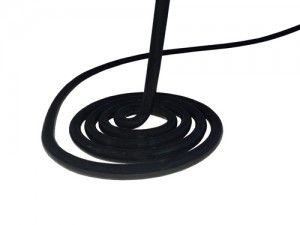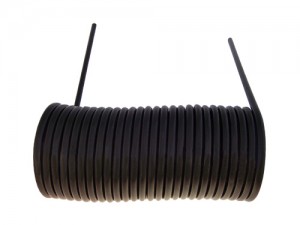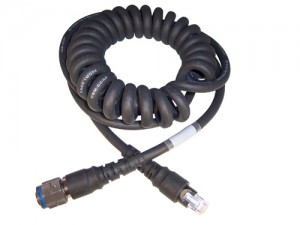Clever design twists on coil cords improve reliablity
Take a close look at industrial automation or military systems, and you’ll probably see a coil cord or two. You may not give them a second thought, but you should. These retractable power and signal cords can play an outsize role in improving the entire system’s performance and reliability.
If you’re accustomed to thinking of coil cords as commodity items, you may think of these cords only in terms of the required electrical and mechanical specifications—such as number and size of conductors and the forces to extend or retract the cord. But there’s more to coil cord design than a few simple specs.
C&M Corp.’s engineers have developed a different twist on the classic coil cord geometry by creating a “pancake” cord whose coils nest within one another concentrically.
Increasingly, the best cords incorporate non-traditional design features that help solve more fundamental engineering challenges such as cost reduction, space constraints and reliability. Four such coil cords each feature a design innovation that allows the cord to do more than simply deliver power.
Rising cable cord lays nearly flat
Nearly all coil cords have a similar arrangement of same-sized, parallel coils. Our engineers have developed a different twist on the classic coil cord geometry by creating a “pancake” cord whose coils nest within one another concentrically. This arrangement results in a coil whose retracted height equals the outside diameter of a single cable. The straight tangent end of this cord design rises perpendicularly from the center of the coils.
Nearly all coil cords have a similar arrangement of same-sized, parallel coils. Our engineers have developed a different twist on the classic coil cord geometry by creating a “pancake” cord whose coils nest within one another concentrically. This arrangement results in a coil whose retracted height equals the outside diameter of a single cable. The straight tangent end of this cord design rises perpendicularly from the center of the coils.
Based on an 18 AWG/22 AWG/28 AWG cable, the first of these pancake cords has a 4-in. diameter and a height of 0.340-in. when retracted. The extended cord offers up to 1 ft of travel. Extension force is 1.7 lb.
Other than its unique coil arrangement, this cord is much like a more traditional model in its capabilities. Nearly any type or size of cable would lend itself to this design, which did require the development of a new manufacturing process with customized fixtures. The only design concession to the pancake shape is the need to use high-performance jacket compounds—either urethanes or thermoplastic elastomers. Jacket material selection is crucial to ensuring that the cord does not suffer from any “memory effects” that would keep it from returning to its flat pancake after repeated cycles.
Initially developed for an industrial automation application, our lay flat coil cords could be a good fit for any type of robot or moving machine that is short on space for cabling. In new machine designs, this cord could easily be installed in a shallow recess, making it disappear in its retracted state.
Intended for use in an oil-and-gas application, this monster coil cord has a coiled section that measures only two-feet long. But its tangent ends measure 16 ft on one side and 96 ft on the other.
Long ends eliminate connectors
Coil cords tend to be compact, with short, coiled sections and tangent ends measured in inches not feet. Recently, however, we designed and manufactured a coil cord that pushes the boundaries in terms of size.
Coil cords tend to be compact, with short, coiled sections and tangent ends measured in inches not feet. Recently, however, we designed and manufactured a coil cord that pushes the boundaries in terms of size.
Intended for use in an oil-and-gas application, this monster coil cord has a coiled section that measures only 2-ft long. But its tangent ends measure 16 ft on one side and 96 ft on the other. Manufacturing such a large coil cord structure forced us to overcome some difficult manufacturing challenges. For instance, we had to find new ways to fit such a large cord into our oven for coiling.
So why bother with the extra effort? The answer comes down to eliminating points of failure. The alternative to this coil design would have been shorter coil cord tangents connected to longer sections of straight cables. In this oil field application, the connectors between the coiled and straight sections would have created maintenance headaches and a potential point of failure.
Oil-and-gas applications aren’t the only ones that can make good use of extended tangents. Many lighting and industrial applications can similarly benefit from a reduction in the number of cable connectors needed as circuit lengths increase.
Made with urethane jacketing, an TPE inner core and a new spiral EMI shield, these ruggedized coil cords from C&M Corp. support fast Ethernet data rates.
Rugged Ethernet design supports fast data rates
The growth of Ethernet control networks in both industrial and military applications has created a need for coil cords that can reliably handle fast data rates. Yet that’s easier said than done because the coiling process and field use tend to degrade the integrity of the conductors and shielding, potentially to the point of data loss. We’ve recently addressed the data loss issue with the development of a ruggedized Ethernet coil cord.
The growth of Ethernet control networks in both industrial and military applications has created a need for coil cords that can reliably handle fast data rates. Yet that’s easier said than done because the coiling process and field use tend to degrade the integrity of the conductors and shielding, potentially to the point of data loss. We’ve recently addressed the data loss issue with the development of a ruggedized Ethernet coil cord.
Made with urethane jacketing, a TPE inner core and a new spiral EMI shield, these ruggedized coil cords support fast Ethernet data rates.
Though less than a year old, these new coiled Ethernet cords have already started to appear in military and industrial automation settings. In most applications, these cords are overmolded with integrated RJ-45 connectors—to provide functional strain relief, protection from harsh operating environments and tamper resistance. The operating temperature range for the new cords spans a wide range from –40 to 90° C.
Materials upgrade reduced total cost
With coil cords, you usually get what you pay for—and then some. Consider, for example, a four-conductor, 12-gauge coil cord that we developed to bring power to a large soot blower. Designed to travel over a braided metal support wire, the original cord was constructed with a low-cost rubber jacket. The upgraded cord featured a more costly Hytrel thermoplastic elastomer jacket compound and integrated connectors. So you might think that the upgraded cord would cost more than the original cord.
With coil cords, you usually get what you pay for—and then some. Consider, for example, a four-conductor, 12-gauge coil cord that we developed to bring power to a large soot blower. Designed to travel over a braided metal support wire, the original cord was constructed with a low-cost rubber jacket. The upgraded cord featured a more costly Hytrel thermoplastic elastomer jacket compound and integrated connectors. So you might think that the upgraded cord would cost more than the original cord.
But think again. The new cord actually costs about 50% less than the old one in spite of the more expensive jacketing material. The reason comes down to performance. The use of a higher-performance jacket material enabled a longer extended length despite a shorter retracted size. The new cord extends to nearly 8 ft for a 4-in. coil diameter, compared with 3 ft for the old cord. So the user could buy less cord for the same travel length.
The new cord also offered wear advantages that contribute to a longer lifecycle. The old rubber cord had a high coefficient of friction (COF) against the steel support cord, causing it to drag and wear out prematurely. The new Hytrel-jacketed cord, which has a lower COF, slips over the support wire smoothly for a longer life.
The notion that a seemingly expensive materials upgrade can actually drive down lifecycle costs is a familiar one to many engineers. Just remember that it applies to coil cords too.





Comments
Post a Comment